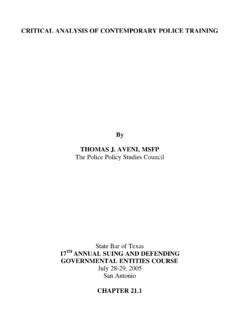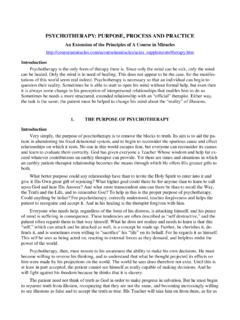Transcription of Police Marksmanship Under Fire - Police Deadly …
1 Officer-Involved Shootings: What We Didn't Know Has Hurt Us . By Thomas J. Aveni, The Police Policy Studies Council Long debated, the nature of Police shootings elicits considerable emotion, as well as ample dosages of misinformation. Central issues of concern and contention have long been severe errors in judgment, and dismal handgun hit ratios. But, there is much, much more to chronicle that has never been fully explored. Police handgun hit probability has long been an area of focus amongst Police trainers, and has generally been discussed within the realm of (1) low expectations of Police gunfight performance based on historical data, (2) whether the way in which Police are trained has contributed to low hit probability, and (3) whether physiological and psychological impairments experienced in critical incidents contribute to degradation of performance.
2 This article will address those issues, and many more beyond them. Anyone attempting to research the Police use of Deadly force encounters a myriad of hurdles. The most formidable impediment to this research is the fact that most agencies don't collect such data. Some simply refuse to do so in apparent concern that such data will be misinterpreted and misused. There seems to be substance to such concerns, as varying agendas were encountered while gathering this data. The author has expended considerable effort to avoid the politics embedded within this material, maintaining focus on problem-solving objectives.
3 Of the few agencies that actively collect gunfight data, even fewer choose to freely share it. Those that do share their data tend to offer it in a sterilized table format that makes detailed analysis difficult. As this article progresses, you'll see how the devil has long been hidden in the details of gunfight data. The reader should also be aware of the fact that much of An edited version of this this data was culled from sources with considerable structural disparities between their data formats. The most useful and article appeared in the enlightening information was culled from loosely structured August 2003 issue of shooting narratives.
4 Often, many of the most crucial shooting Law & Order magazine variables were unavailable from these sources, simply because certain salient questions ( , distance at which shots were fired, number of hits on intended targets, hits by caliber where multiple weapon types were involved, light conditions, whether officers made independent threat identifications in bunch-shootings, etc.) about the events were never asked. In effect, these gross disparities in data collection make inter-agency comparisons extremely difficult. To close these information gaps, the law enforcement community will ultimately have to embrace a standardized Deadly force reporting mechanism.
5 The Newhall Wake-Up Call The single incident credited with initiating the Police officer survival movement was the April 5, 1970 gunfight that left four CHP officers (officers Frago, Gore, Pence and Alleyn) dead in Newhall, California. That brief armed encounter, with two convicted felons, brought considerable attention to a host of deficiencies in Police training. One issue illuminated by the Newhall incident was the fact that the four CHP officers fired fifteen rounds, three of which were 12-gauge buckshot cartridges, yet inflicted only one superficial wound upon their assailants. Typical of Police confrontations, all rounds expended by the four 2.
6 Deceased officers appear to have been within seven yards of their adversaries. Also typical of Police lethal encounters was the fact that the Newhall firefight occurred during hours (11:54 PM) associated with adverse lighting conditions. Atypical was the duration of that firefight, as it lasted an estimated four minutes. The Newhall incident shocked the law enforcement establishment. It became fodder for Police training films and printed training narratives for many years to come. But, what did the law enforcement community actually learn from this tragedy? Perhaps not as much as we thought we did. NYPD SOP #9: America's First Exhaustive Firearms Discharge Report Implemented in 1970, NYPD's Standard Operating Procedure #9 became an instant vehicle of enlightenment.
7 SOP-9, a formal "Firearms Discharge Report," was implemented to establish documentation of all gunshots fired by NYPD officers. As you might imagine, ammunition expended in training and recreational shooting pursuits were (and are) exempted. However, firearms incidents as diverse as gunfights and officer suicides are documented, as are all "accidental" discharges of firearms. While imperfect from the outset, SOP-9 ventured where few agencies had previously dared to go. The brainchild of NYPD's Frank McGee, SOP-9 became the Holy Grail to inquisitive Police trainers. Old But Still Relevant In reviewing even earlier annual issues of NYPD's SOP-9, it became apparent that we remain pressed by many issues that Police trainers grappled with decades ago.
8 For instance, the 1981 issue of SOP-9 notes, It has been said that if a man can hit a target at 50 yards he can certainly do the same at three feet. The reports do not bear out that assumption. Standard revolver courses of fire may have little relationship to an individual gunfight.. Sighted Versus Unsighted Shooting There is little national data regarding how often officers have used their handgun sights in armed confrontations. What has been available has offered an interesting but inconclusive perspective on sighted shooting. In 1981, NYPD's SOP stated, Good sight alignment is fundamental to target shooting, yet 70% of cases reviewed indicated that no sight alignment was employed when the revolver was fired.
9 It also suggested that the tendency to use sighted shooting increased as the threat distance increased. Aiming was described as diversely as merely using the barrel as a pointing reference, to using only the front sight as an aiming reference, to full utilization of front and rear sights. A. substantive number of officers (10% in 1981) stated that they couldn't remember whether or not they used their sights. To date, the author has been unable to collect hard data pertinent to the efficacy of point- shooting, or any reasonable facsimile of point-shooting ( , threat-focused shooting , et al.). No such data has been made available to me.
10 Attempts were made to obtain such data with one large west coast agency that reportedly has done well with such techniques. But, they either refrain from keeping gunfight data, or keep it Under lock-and-key. While conceding that the viability of threat-indexed 3. shooting is very plausible, it should also be noted that nothing substantive has been uncovered to assess its utility with. What we might loosely construe from the limited NYPD data is that officers (70% of the time). are in fact already point-shooting in a very real sense, and that it could be the reason why hit probabilities appear so dismal.





